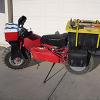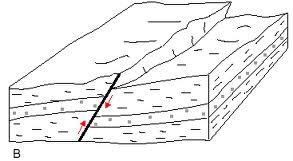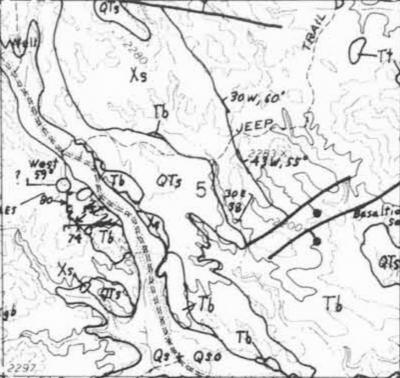-
Posts
119 -
Joined
-
Last visited
Content Type
Forums
Detector Prospector Home
Detector Database
Downloads
Posts posted by azblackbird
-
-
Nice video, just what is that little bike your riding?
Ivan, that bike is called a Rokon. It's basically a modern day mule. It will carry just about anything you can throw on it. Will go just about anywhere you want to go, and the best of all... you don't have to feed or water it. Makes for the perfect prospecting vehicle.

-
That was cool. My first prospecting trip into Arizona. Can you describe "the fault line" please? Is that the same as a "contact zone"?
This particular fault I was investigating and detecting around was a simple thrust fault with various strikes and dips that ran for 1/2 mile or so before intersecting on both ends with other faults. I just so happened to find some of the more visible portions and thought it might be worth looking into. I'll be investigating the intersections in the future.
I'm no geologist, but I would define "contact zones" as where one type of rock meets another type of rock, which BTW is also something I was investigating, as the area I was in contains old Proterozoic basement rock (schist, gneiss, and phyllite) metamorphosed with newer Miocene (basalt, andesite, and rhyolite) volcanic rock. Those separations, or contacts are evident in the video if you look closely. Basically I was just out testing some of my theories. Here's the geology of the particular area I was exploring. Where it says "30W, 60°" on the map is the general area I was detecting.
-
Glad you enjoyed it. The AZ desert would be perfect without all the plants and trees trying to poke and stick you. When riding in the middle of the desert here, you'd better have that perfect line planned well in advance, or else you might find yourself in the middle of a cholla patch. Worst cactus there is. They call them "jumping cactus"... you barely touch them and they're on you. Major pain in the butt to get off. Carrying needle nose pliers and tweezers when off-roading is a prerequisite. Elmer glue works great for the fine stuff that you can't get out with the tweezers.
-
Between cutting firewood, and gleaning the neighborhood citrus trees to give to the food bank, this is the first time I’ve had a chance to get out this month.
I decided Sunday would be a good day to prospect one of the many areas I have marked on my geology maps. This area caught my attention because of a nice fault line running through it, and also because of the various geological changes. It’s in a known gold district, but hasn’t seen very much activity (claim wise) over the years, so I figured maybe it’s time to give it a look see. There’s a producing gold mine about 1/2 mile NW of where my prospects are located. I’m thinking (hoping more like it) that maybe some of those veins from that mine (or possibly other unknown deposits) may have leached out in some of the areas I have marked to explore.
Anyway... here’s some video I shot of my day out... hope you all enjoy. Make sure to watch it in HD for the full effect.

-
De Re Metallica was published in 1556 and would tell much of what you would need to know today.
Came across references to that book when I was doing research on refining. Amazes me how little has really changed.
-
Yeah, unlike wandering the hills digging junk!
I'd rather be out wandering the hills in my own peaceful solitude, rather than trying to chase down old computers, cell phones, and other electronic junk to make a dime. That's just me though.

-
In 2014, I removed the gold plating from a bunch of electronics.
That's a big business for many. A lot of guys on this forum are into the scrap gold business gleaned from electronic parts. Seems labor intensive to me, but to each his own.
-
If I had ounces and ounces of fines, I'd probably play around with some aqua regia and then cast my own PAMPs if not for the cool factor of having my own gold bars. At least I'd know exactly what I would be getting from a refiner if I were to sell them.
-
I'm not at the professional level yet where I can hit a target, pinpoint it with my detector, then dig the target out in one fell swoop. I usually hit the target, dig or scrape the dirt, then swing the detector over the target to pinpoint it again, then dig a little more, then swing the detector to pinpoint it again, then dig a little more, then put the loose dirt that I think contains my target in my scoop, and then wave it over my coil. If the target is not in the scoop, then I swing it once more over the dig area to pinpoint it once again, dig a little, scoop the dirt, wave over the coil, finally hit the target in the scoop, then half the scoops until I can get a visual on the target or pick it out.
My new method... hit the target, pinpoint with the coil, mark the point, put the detector down, and then whip out my pick and the TRX and proceed to find the target (usually in less than 30 seconds) vs. the several minutes it usually takes me with the detector.
-
So I thought I would try a small nugget with the x-pointer, don't know the size of this nugget but the x-pointer would not detect it, Yes it was on level 4..
I'd have no problem picking that up with the TRX. I put a 3 grain piece of lead in a pan full of heavily mineralized dirt/gravel and was able to find it in about 5 seconds.
-
I like the OP's style. He's on the right track with the mentality associating coin, jewelry, and relic hunting to nugget shooting. Both are similar in nature whether people realize it or not. Glad I have a TDI Pro. Maybe not the latest and greatest, but will definitely hang with the big boys when it comes to shooting for nuggets, jewelry, coins or relics.
-
Gotta love it. Wait a few months when the latest and greatest is released and invariably there is always somebody selling at a discount. Patience is a definitely a virtue in the detecting world.

-
That is one awesome looking specimen! No HF treatment needed. Perfect the way it is. Nice find!
-
Question... shouldn't those that detect learn to listen to what their detectors are telling them vs. what they are showing them? My GMT has the LCD readouts, but it's very rare that I even look at the screen. I try to tune my ears to the ground rather than my eyes.
I would think it would be the same for the coin and relic hunters. Don't those detectors sound off differently on the various types of metals and ground mineralization?
Call me crazy, but I think all those fancy smancy digital readouts and color LCD screens are nothing but marketing hype. Am I right or wrong?

-
I would have to pick White's out as the company that stands out for service. They will repair 40 year old models if they can get the parts.
I'm not brand loyal to anything, but I do have to admit that after doing some careful research, and from reading of the many people who rave about their exemplary service and attention to their customers, the White's products are all that I currently own at this time. TDI Pro, GMT, and TRX pinpointer. All good products in my book, and if the factory stands behind them, that's even all the better.

-
What amazes me is that back in the day, many of the roads (and even the railroads) that lead to the many various mines throughout the Bradshaws were considered highways by today's standards. They were well maintained and frequently graded.
Nowadays many of those same roads and rail beds are nothing but rough and rock strewn trails just wide enough to ride a horse or a motorcycle on. I know of at least 6 abandoned bulldozers and excavators that are sprinkled throughout the Bradshaws, that if you were to take a trail to get to them, you'd wonder how they ever got there in the first place. A couple of them are on the sides of mountains so steep, you almost need a rappelling rope to get to them. Just totally dumbfounds me what they could accomplish back then.
Many of those old mines and mills in the video used to employ many hundreds if not close to a 1000 workers or more, and the now mostly nonexistent towns that sprung up around those old mines and mill sites, used to be some of the most populated cities/towns in Arizona at one time or another.
Just amazes me how Mother Nature can heal so quick. 100 years is a flea turd on an elephants a$$ in the overall scheme of things. Too bad the "greenies" don't possess the common sense to realize that.

-
Here's a video one of my dirt biking buddies shot a few years back. It's pretty solid proof that Ma Nature has a way of taking care of herself...
-
Nice stuff HF - i'll rush right out and get me some. My pal the Chemical Engineer has bad dreams about this stuff - it is used in huge quantities in microchip fabrication - one of those "clean industries".
HF when properly used and stored is no more dangerous than many of the other thousands of toxic chemicals that are contained in, or used in the manufacturing of products we all use on a daily basis.
-
AZblackbird - HF treatment is quite the art and I've heard plenty of stories of prospectors who turned pretty specimens into piles of tiny bits and wires of gold. It is very easy to over do it - if you take away all the rock, it can just fall completely apart.
Yep I agree. HF treatment is an art. Thus the reason I said with the "right" HF treatment and those species would turn into works of art that even many non-gold collectors would pay a handsome price for.
-
But for areas out of coverage I picked up a DeLorme InReach Satellite Text Communicator to replace my Iridium satellite phone. Need a sat phone? Mine will be for sale very soon.
I barely talk or text on the phone I have. SPOT has been doing me fine for many years now. If anything, I'll eventually add an aircraft radio to the mix just for an added safety factor. Last Saturday I was out in a remote location and was pleasantly surprised by the amount of air traffic. I counted at least 3 or 4 planes and even one helicopter throughout the day that I could have easily communicated with if things went south.
-
Ten years from now I will not be wondering how to get back to someplace. I highly recommend prospectors just make a habit of it.
Ditto... been carrying a GPS since Garmin came out with the first GMAP. Still carry one to this very day as a back up to my main one. I always carry a SPOT also. Keeps the S.O. pacified. Cell phones are worthless where I go, so I just keep mine off.
-
Dayyummm... the right HF treatment on those species and you could easily quadruple their worth. Nice score!

-
Amazing what all goes into running a mine. The technology and engineering they had back then rivals even what we have today.
-
Should I just get used to what the controls do in the backyard and go prospect and learn more about the environment IN the environment?
You answered your own question. Good job and good luck.






More Gold Prospecting and Rokon Porn...
in Detector Prospector Forum
Posted
I suggest you study up on the laws. When out prospecting, I'm operating under the Federal and AZ state mining laws. Everything I do is perfectly legal.